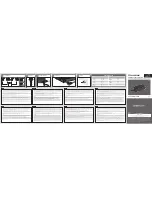
User's Guide HDSPe MADIface
© RME
17
DDS
Activates all settings of this dialog.
Value
Shows the sample rate as adjusted in this dialog. The sample rate is defined by the basic set-
ting (frequency), the multiplier, and the position of the activated fader.
Frequency
Sets a fixed basic sample rate, which can be modified by multiplier and fader.
Freq. Multiplier
Changes the basic sample rate into Single, Double or Quad Speed mode.
Coarse
Fader for coarse modification of the basic sample rate. Click
Active
to activate it. Minimum step
size 1 Hz.
Fine
Fader for fine modification of the basic sample rate. Click
Active
to activate it. Minimum step
size 1 Hz.
Notes on the faders
A mouse click within the fader area, above or below the fader know, will move the fader with the
smallest step size up or down. Holding the Ctrl key while clicking will cause the fader to jump to
its center (0) position.
11.3 Clock Modes - Synchronisation
AutoSync
AutoSync guarantees that normal record and record-while-play will always work correctly If no
valid input signal is found, the card automatically switches to clock mode ‘Master’. In certain
cases however,
AutoSync may cause feedback in the digital carrier, so synchronization breaks
down. To remedy this, switch the clock mode to 'Master'.
Thanks to its AutoSync technique and lightning fast PLL, the HDSPe is not only capable of han-
dling standard frequencies, but also any sample rate between 28 and 200 kHz.
SyncCheck
If several digital devices are to be used simultaneously in a system, they not only have to oper-
ate with the same sample frequency but also be synchronous with each other. This is why digi-
tal systems always need a single device defined as ‘master’, which sends the same clock signal
to all the other (‘slave’) devices.
Remember that a digital system can only have one master! When the HDSPe’s clock mode
is set to Master, all other devices must be set to Slave.
SyncCheck
serves as simple check and display tool of the current clock situation. It indicates
whether there is a valid signal (Lock, No Lock), or if there is a valid
and
synchronous signal
(Sync) at the MADI input.
In practice, SyncCheck provides the user with an easy way of checking whether all digital de-
vices connected to the system are properly configured. With SyncCheck, finally anyone can
master this common source of error, previously one of the most complex issues in the digital
studio world.
Summary of Contents for Hammerfall HDSPe MADIface
Page 5: ...User s Guide HDSPe MADIface RME 5 User s Guide HDSPe MADIface General...
Page 34: ...34 User s Guide HDSPe MADIface RME...
Page 35: ...User s Guide HDSPe MADIface RME 35 User s Guide HDSPe MADIface Connections and TotalMix...
Page 38: ...38 User s Guide HDSPe MADIface RME...
Page 60: ...60 User s Guide HDSPe MADIface RME...
Page 61: ...User s Guide HDSPe MADIface RME 61 User s Guide HDSPe MADIface Technical Reference...
















































